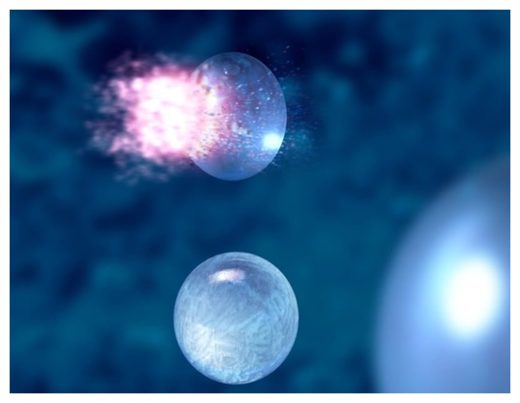
Ordinarily, water freezes at 0°C, when its molecules stop moving fast enough to overcome the forces between them, clicking together to form a crystalline lattice. This isn't a hard and fast line, though: that lattice generally needs a "seed" disturbance to act as a starting point. Under the right circumstances, like if it's free of large impurities and chilled in a very smooth-walled container, water can get well below its freezing point before crystallizing. So-called supercooled liquids can do some super-cool stuff, like freezing all at once when disturbed.
Since a solid is in a lower-energy state than a liquid, liquids can actually release a good deal of heat when they crystallize, too. Though it might sound paradoxical, farmers will sometimes spray water on their crops before a chilly night to prevent frost damage. Chemical hand warmers work the same way, with sodium acetate-a chemical that's got a high freezing/melting point. Since any temperature below 137°F is "supercooled", the sodium acetate in the bag gets nice and toasty as it crystallizes, and can be recharged by boiling. (Watch video below)
Everyday uses aside, supercooling has some important scientific applications. As abundant as it is, water has some really weird quirks, and they only get weirder when it drops below its freezing point, with properties like the water's specific heat (the amount of thermal energy it takes to change a substance's temperature) growing exponentially. Getting water down to 228 Kelvin-or about -45°C-is a big target for scientists, because projections based on current data imply a "singularity" here-with the specific heat rising to infinity. Nobody knows what that really represents physically, but the debate rages on among theoretical physicists, and experimentalists are hard at work trying to find out.
A collaboration of scientists, hailing from seven different institutions spanning four European countries, has recently made a big step in that direction-getting to within 2°C of that target temperature-using a clever combination of cooling and imaging techniques. The group reported their findings in a paper slated for publication in the American Physical Society's Physical Review Letters journal.
The tricky part about creating and measuring such supercooled states is that they don't tend to last very long. In the GIF above, it takes banging the water bottle against a table to get it to freeze, but when you're talking about the much lower temperature regime scientists are trying to explore here, the liquid becomes a lot more sensitive-things like ripples on the surface can trigger a freeze. This becomes all the more difficult when you're using evaporative cooling, since it relies on large amounts of air moving over the water's surface. On top of that, you can't exactly stick a thermometer into the water droplets to see how cold you've gotten them-they're only a few millionths of a meter across, they're flying through the air at high speed, and perturbing them with a physical probe would trigger a freeze.
Why are they flying through the air? Although that's part of the problem here, it's also part of the solution; the experiment involved creating a stream of identical-sized droplets fired from a nozzle at high speeds-at a certain point, it's easier to move the water through the air than to move air over the water. This technique also helped scientists get around the unpredictability of the freezing process by imaging a huge number of droplets, rather than focusing on creating the ideal conditions for a single mass of water to remain liquid-a kind of "throw it at the wall and see what sticks" approach.
The real stroke of genius in this experimental setup, though, was the scientists' realization that the easiest way to measure the water droplets' temperature was actually to measure their size.
When a molecule of water drifts off the surface of a volume, a very certain amount of thermal energy goes along with it, leaving the remaining water colder-this is how sweating works to keep us cool. Since the experiment's nozzle created identical droplets, measuring the droplets' diameter downstream told the researchers exactly how much water had evaporated from a given droplet-along with how much heat had been sucked away with it.

For all this, we're still not sure what that "singularity" looks like, but we're now just a few degrees away. Maybe 228 K is the hard line where all water must freeze, or maybe exciting new properties emerge in water at that temperature-after all, few would have expected the superconductivity transition that occurs in certain materials at a suitably low temperature.
What secrets does water still hold? Only time-and creative science like this-will tell.



Reader Comments
to our Newsletter